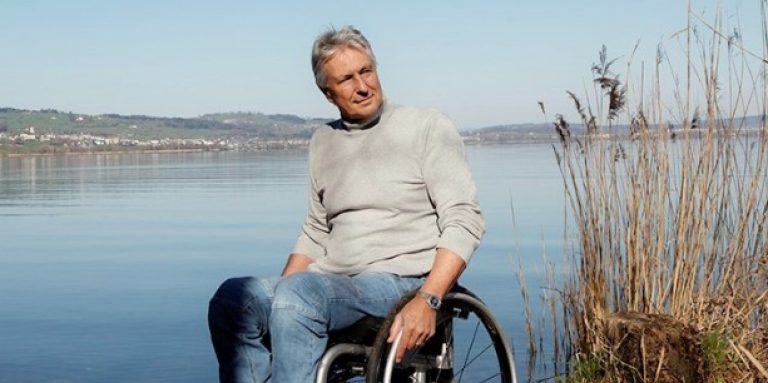
Spinal cord injury: paraplegia and quadriplegia
What is a spinal cord injury and what impact does it have on those affected? Here’s the lowdown. Karl Emmenegger also gives us an honest insight into life in a wheelchair.
Losing your ability to walk or use and feel your legs – and sometimes also your arms – from one day to another is a life-changing experience. You suddenly need to get to grips with using a wheelchair. In your everyday life, you constantly encounter inconveniences such as steps you can’t climb or supermarket shelves you can’t reach. The impact on your personal and professional life is far-reaching. However, all that is just one aspect of life with a spinal cord injury. The associated health consequences are another.
What are spinal cord injuries?
Let’s imagine the brain as a kind of ‘control unit’ for our body. It controls our body – our arms, legs and internal processes such as breathing, circulation and digestion – via the spinal cord. If the spinal cord is injured, some or all of the transfer of information between brain and body is no longer able to take place. The brain sends a signal that then gets “stuck” at the injured section of the spinal cord and is not passed on. As a result, the legs, and sometimes also the arms, are paralysed. Depending on how high up the injury is, the effects differ. Spinal nerves run along the full length of the spinal column through the small spaces between the individual vertebrae. The spinal nerves that control the arms and hands begin at the neck vertebrae. The ones that control the legs (as well as the bladder, bowels and genitals) start from certain vertebrae in the lumbar and sacral areas. As well as visible restrictions of movement and paralysis, this may result – depending on the height at which damage to the spinal cord has occurred – in many other concomitant and resulting conditions. The higher up the injury, the more areas and functions of the body are affected.
Causes of spinal cord injuries
The spinal cord can be damaged by injuries to the spinal column. However, they can also be caused by conditions such as tumours, infections and bleeding. In rare cases, children may be born with a spinal cord injury, such as those who have spina bifida.
Many people survive a sports injury, falling from a ladder or a motorbike accident with just a shock. For others, it’s the beginning of a difficult journey. Forty-two years ago, Karl Emmenegger met this fate. A road accident transformed his life in a second:
“I nodded off for a second while driving and my life changed forever. I was twenty-seven years old, a stunt pilot and a handball player for the National A team. I was studying mechanical engineering. Then, all of a sudden, I was paralysed from the twelfth vertebra onwards.”
Types of spinal cord injury: paraplegia and quadriplegia
Paraplegia
People with paraplegia are paralysed from the waist down. Their legs, buttocks, stomach and lower chest are paralysed – depending on the location of the injury. The spinal cord has been injured in the thoracic, lumbar or sacral area. People with paraplegia can move their arms freely, and their respiratory muscles are also mostly unaffected.
Quadriplegia
Unlike paraplegia, quadriplegia paralyses the arms and hands as well as the legs and torso. The damage to the spinal cord is in the cervical spine. Depending on the height of the injury, those affected may still be able to move their arms a little. People with quadriplegia also have trouble with their respiratory muscles. Depending on their condition, a person with quadriplegia may require breathing assistance. Regulation of circulation can also be affected.
“I knew from a young age that I wanted to be a father. My accident destroyed my sexual nervous system. I was no longer able to produce sperm, so I was unable to have kids. That was awful.”
People with quadriplegia almost always experience bladder, bowel and sexual dysfunction. This is because the nerves that control these run from the brain through the spinal cord down to the sacral area. Men are affected by sexual dysfunction and infertility. Nowadays, sperm can be obtained from men who wish to have children. Women with a spinal cord injury are still able to become pregnant and carry a child.
“I struggled with the absence of sexuality in my life. For a long time, this was horrific, and almost tore me apart. It took me until I was nearly fifty to rediscover my masculinity. That’s when I met the woman who became my wife.”
People with paraplegia and quadriplegia also need to come to terms with other indirect consequences of their spinal cord injury. These include pressure sores – areas of pressure that are no longer supplied with blood and which go unnoticed. Other effects include uncontrollable, often painful muscle cramps. These occur because the nerve connection from the brain that is responsible for fine motor control in the brain has been interrupted in the spinal cord.
“I’m very lucky with my body. For instance, I’ve never had phantom pains or pressure sores. As an athlete, I was very fit, too. It’s very important that I maintain my weight. My body weight mustn’t weigh on my joints. Maintaining good digestive health is also important. Of course, I will have a steak and chips from time to time – but then I need to live with the consequences.”
Complete and incomplete spinal cord injury
If someone with paraplegia or quadriplegia is unable to move and feel their limbs, this is known as complete spinal cord injury. The spinal cord is either completely severed at the point of injury, or swelling and poor circulation have caused functions to break down completely.
People affected by incomplete paraplegia or quadriplegia, however, can still feel pressure or pain beneath their damaged spinal cord and move their legs and arms a little.
“Unfortunately, the vertebra affected was only compressed, not broken, which made the treatment a bit more complex. Today, they would operate, but back then, they didn’t dare try. Instead, they hung weights from my head and legs for two months. The doctors’ aim was to reset the compressed vertebra, but this didn’t succeed entirely. It was torture.”
Impact and effects on life
Spinal cord injuries completely transform the lives of those who experience them. They can no longer walk, and, depending on their situation, they may no longer have use of their arms – and they have to learn to live with many concomitant and resulting conditions.
Spinal cord injuries were previously associated with a high death rate. People with paraplegia and quadriplegia frequently died from kidney conditions caused by a build-up of urine and urinary tract infections.
Nowadays, fortunately, the death rate has fallen dramatically. Thanks to innovative new operating techniques, better medical and surgical care and rehabilitation, individuals affected by spinal cord injuries not only live longer – they can lead fulfilling and productive lives. The way society treats people with disabilities has also changed significantly for the better in recent decades. Those affected are more accepted and integrated into professional and social circles.
“After the accident, I needed a career change. I didn’t plan to live on disability insurance. But people like me who wanted to build a new life didn’t get enough help back then. In rehab, I was only given superficial advice. The term ‘career’ didn’t exist in the disability insurance legislation back then. In rehab, I met Dr Guido Zäch. When he was planning the Paraplegic Centre in Nottwil in 1989, I told him that careers advice for people in wheelchairs had to be improved, and developed a concept. He immediately made me the head of careers advice and professional training at his new centre. I wasn’t even a careers advisor! But Zäch encouraged me to become one. I was so lucky to be able to do this training. The next twenty-five years were wonderful. By the time I retired, I’d worked with around 2,000 people. I saw time and time again how incredibly resourceful we are as human beings. Here’s the important thing: to change a situation, you need belief and a vision for the future. As a person with paraplegia, I’ve witnessed huge social progress over the years. Society gives us a chance nowadays. I’m incredibly proud to have played my own small part. Looking back, I can say: I’ve had an absolutely fantastic life.”

Dr Guy Waisbrod is a senior consultant for spinal surgery at the Swiss Paraplegic Centre, Nottwil. He also heads the project of an interdisciplinary back centre. Guy Waisbrod gave the editorial team advice and input for this article.


Newsletter
Find out more about current health issues every month and get all the information you need about our attractive offers from all Helsana Group companies * delivered by e-mail to read whenever it suits you. Our newsletter is free of charge and you can sign up here:
We did not receive your information. Please try again later.
* The Helsana Group comprises Helsana Insurance Company Ltd, Helsana Supplementary Insurances Ltd and Helsana Accidents Ltd.